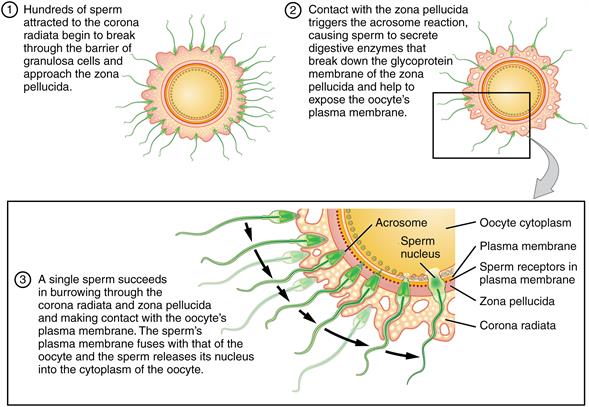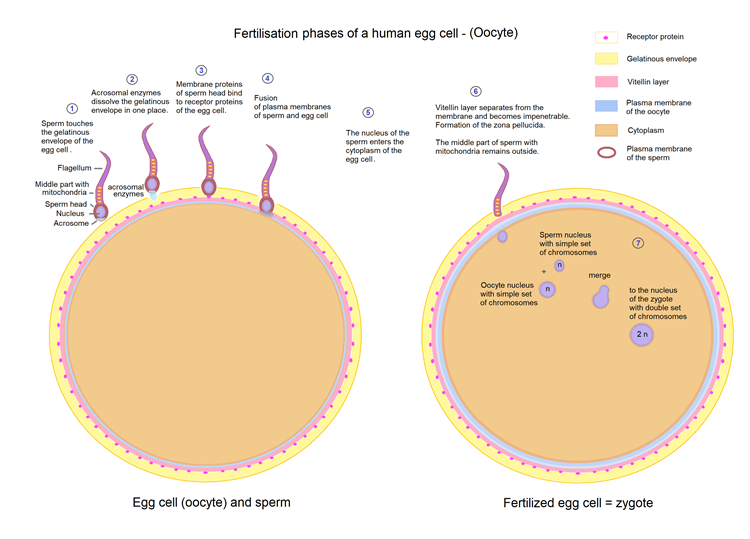
PUMPA - SMART LEARNING
எங்கள் ஆசிரியர்களுடன் 1-ஆன்-1 ஆலோசனை நேரத்தைப் பெறுங்கள். டாப்பர் ஆவதற்கு நாங்கள் பயிற்சி அளிப்போம்
Book Free DemoIn the previous section, we have seen the process of gametogenesis. Following gametogenesis, gamete transfer occurs during sexual intercourse. In humans, fertilisation is internal and takes place in the oviduct or fallopian tube of the female reproductive tract.
Fertilisation takes place mostly in the ampullary region of the fallopian tube. After being released from the follicle, an oocyte is alive for over 24 hours.
Therefore, fertilisation must take place within 24 hours. Male discharges semen into the female's vagina close to the cervix during sexual intercourse or copulation. From the vagina, the sperm swims up the uterus and then enter the oviducts. Initial transportation of sperms is by the uterine and fallopian tube contractions.
Later, the sperms swim using their tail (due to its motility) in the fluid medium to enter the ovum to fuse with it. Numerous sperms surround the ovum, but only one sperm succeeds in fertilising the ovum. As soon as a sperm enters the ovum, chemical reactions obstruct the further entry of any sperm.

Fertilisation events that occur during fertilisation
There is a fusion of male and female gamete resulting in the formation of a "zygote".
Fertilisation is the fusion of a haploid sperm and a haploid ovum to form a diploid zygote.
The zygote is the fertilised ovum. Before fertilisation, the sperm needs to undergo a process called capacitation.
Capacitation:
The changes in the sperm that activate or enable it to fertilise an ovum are called capacitation.
The secretions of the female tract and the acidic environment remove the coating deposited on the sperm's surface. Thus, the acrosome becomes more permeable, and the sperm thus becomes active to penetrate the egg.
The process of capacitation takes about 5 - 6 hours.
Acrosomal reactions:
The acrosome of the sperm thus can secrete the lytic enzymes. The enzymes help the sperm to break down and penetrate the layers of the cells around the ovum. Thus, the sperm comes in contact with the ovum.

Acrosomal reaction
Cortical reaction:
After the fusion of sperm and the ovum, the oocytes display cortical reactions. The cortical granules present in the oocyte fuse with the plasma membrane to release cortical enzymes.
Cortical enzymes harden the surface of the ovum. Thus, it hinders the entry of other sperms. The process ensures that fertilisation occurs with only one sperm.
Formation of the zygote:
The ovum and the sperm fuse together to form a zygote. Once the ovum fuses with the sperm to form a zygote, the corpus luteum formed from the Graafian follicles secretes progesterone and helps in the development of zygote.

Picture showing the different phases involved in the fertilisation of an ovum by the sperm
The following video depicts fertilisation and the acrosomal reaction:
Reference:
https://commons.wikimedia.org/wiki/File:2901_Sperm_Fertilization.jpg
https://upload.wikimedia.org/wikipedia/commons/4/43/Acrosome_Reaction.jpg
https://upload.wikimedia.org/wikipedia/commons/e/e7/Egg_cell_fertilization_-_Zygote.png
https://www.youtube.com/watch?v=TUQP2rxExKo